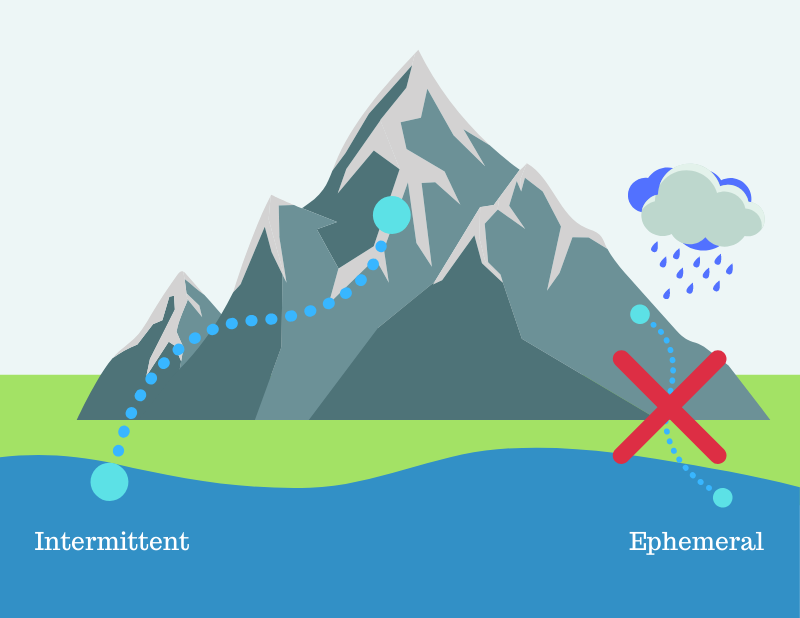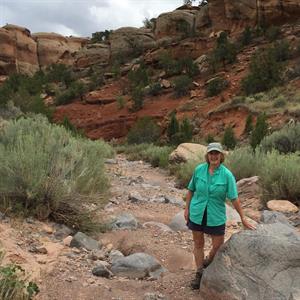Rebecca Shoer, Save Our Streams Coordinator
All water flows downhill, be it along the street, through a city, or even underground. As it flows, water can pick up and carry all kinds of things, including potentially harmful pollutants. By teaching our communities about how local waterways are connected, we can help improve water quality and protect this natural resource for humans and wildlife alike.
Epheme-what? Learn more lingo with our Water Words Dictionary.
When we talk about streams and rivers, we often focus our attention on large and well-known waterways in our community, like the river that flows through the middle of town or the stream where families go fishing. However, we may not recognize the importance of the smaller brooks, creeks, and streams that feed into larger waterways. Many of these small waterways don’t flow year-round: they are either ephemeral or intermittent. But just because these creeks and streams don’t flow continuously doesn’t mean they aren’t critically important to water quality. However, protecting these streams from pollution is a difficult task – and recent changes to the Clean Water Act have only made it harder.
Scientists, decision-makers, and stakeholders across the country have all tried to define “continuous,” “ephemeral,” and “intermittent” streams. Some groups have tried to sort out the confusion by using different terms, like “temporary” or “perennial.” But what does it all mean, and why does it matter?
Generally speaking, an intermittent stream flows regularly (that is, predictably), but not year-round – it may be fed by snow or by a mountain spring that dries up in summer. Ephemeral streams only flow after a precipitation event, like a heavy rainstorm. But these definitions easily become blurred, and classifying a stream can be a matter of one person’s opinion against another’s – and defining a stream as ephemeral instead of intermittent can have huge ramifications.
In January 2020, the Environmental Protection Agency announced a new definition of which water bodies are protected under the Clean Water Act. Under the new “Waters of the United States” (WOTUS) definition, ephemeral streams (those fed by precipitation events) are no longer protected by the Clean Water Act. That means pollution going into those streams – and the polluters who are putting it there – are not regulated by federal laws. Even if water is flowing in these streams, they are not protected.

The intermittent stream on the left is fed by mountain snow and will dry up in summer. The ephemeral stream on the right is only fed by precipitation events like storms. The intermittent stream will still be protected under the new Clean Water Act… but the ephemeral stream won’t.
Of course, this lack of protections doesn’t mean that pollution in the stream won’t be picked up and carried into larger streams and rivers! Streams that don’t flow year-round, or even most of the year, still play a critical role in water quality.
We’ve used data gathered through our Stream Selfie project to create an interactive map of non-continuous streams in America. You can show it to anyone who thinks the new Clean Water Act won’t hurt our water quality.
On this map, you can see where our volunteers have taken pictures of their favorite streams, and which streams do or don’t flow year-round. Most folks submit Selfies from continuously flowing streams and rivers, marked here with yellow dots. Pink dots show streams that do not flow year-round, while blue dots indicate where volunteers weren’t sure if a stream flowed continuously or not.
Many non-continuous streams don’t even have names – which likely means they aren’t on town or county maps, and almost certainly means they aren’t protected. The number of blue “unsure” dots highlights another issue as well: If you aren’t familiar with a stream, you usually can’t tell just by looking whether it flows continuously or not. A stream must be observed regularly over an entire year in order to determine if it is continuous or not, and even then, it may be continuous in wet years and intermittent in dry years. The official decision on whether to classify a creek or stream as continuous, intermittent, or ephemeral is often made without this long-term observation – but the decision will have major consequences for water quality in years to come.
By collecting Stream Selfies and asking observers how often they think the stream flows, we can begin painting a picture of both streams across the country and public awareness of stream behavior. Getting outside to observe your local stream by taking a Selfie, monitoring for macroinvertebrates, or taking chemical measurements provides you and the national clean water community with invaluable data. Even the smallest ephemeral stream plays a role in the water cycle – and by educating yourself and your community, you can play your part in protecting our country’s waterways!
Learn more about our clean water work

Nancy sent us this Stream Selfie from Colorado. "This is a seasonal stream that flows through No Thoroughfare Canyon in Colorado National Monument," she wrote. "It flows into the Colorado River. In the spring you can hike to a pool and two waterfalls on this stream, but during the heat of the summer, the stream goes dry."